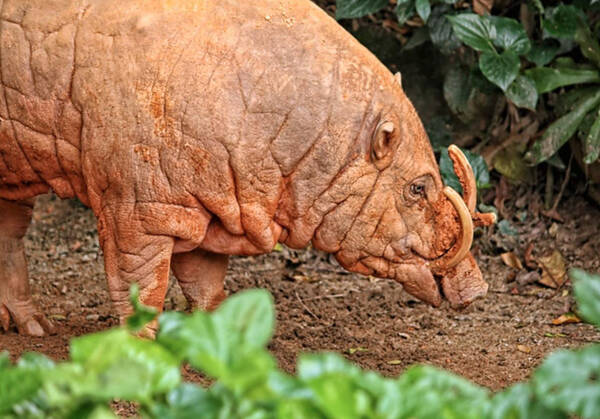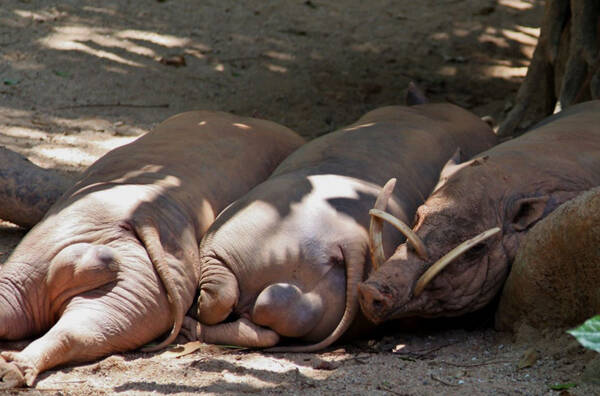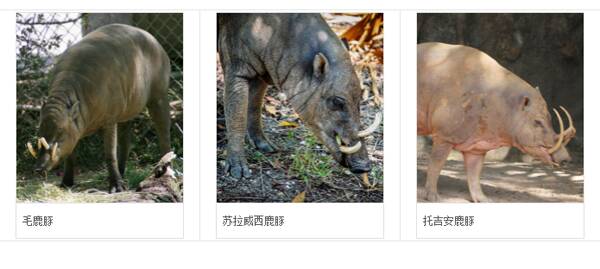Babyrousa togeanensis
IUCN
LCBasic Information
Scientific classification
- name:Babyrousa togeanensis
- Scientific Name:Babyrousa togeanensis,Togian Islands Babirusa,Malengewi babirusa, Celebes babirusa, Celebes wild boar
- Outline:Ungulata
- Family:Artiodactyla Suidae Babirusa
Vital signs
- length:87.7-106.5cm
- Weight:About 100kg
- lifetime:About 20 years
Feature
Very sparse hair, white on the belly and inside of the legs
Distribution and Habitat
The Togean Babirusa is found only on four islands in Indonesia: Batudaka, Togean, Talatakoh and Malenge, as well as Togo and some nearby islands off Sulawesi.
The Togean Babirusa is adapted to primary forest habitats, but also frequents other areas, including agricultural areas, gardens and coconut plantations, secondary scrub, swamps and beaches. It usually inhabits rainforests in rivers and ponds with abundant aquatic plants. The natural vegetation on the Togean Islands consists of different types of moist forests, often varying from monsoon to evergreen depending on the island. The species can also be seen in mixed gardens, regenerating scrub on former slash-and-burn cultivated land, secondary forests, village edges, freshwater swamps and beaches. On the Malenge and Kadidiri Islands, the species is most commonly found in coconut plantations.
Appearance
The head and body of the Togian babirusa are 87.7-106.5 cm long, the tail is 27.3-32.0 cm long, and the weight is about 100 kg. The male Togian babirusa is larger than the other two species in the genus, judging by the size of the skull. Females are about two-thirds the size of males, and are similar in size to other females. Both sexes of this species have very sparse hair on their bodies, ranging from pale in young babirusa to black in adults, and the overall color varies between individuals, from almost golden to almost black. The belly and inner side of the legs are whitish, and this pale color can extend to the upper lip, contrasting with the usually dark forehead. The tail tuft is well developed. Males can be easily distinguished from females by their canine teeth, which have long tusks, with the lower canines extending upward from the lower jaw on both sides. The upper canines are rotated from the base, causing these teeth to protrude through the bridge of the nose and bend back
Details
Togian Babirusa (scientific name: Babyrousa togeanensis) is called Togian Islands Babirusa in foreign language, and has no subspecies.

Male Togian Babirusa usually live alone, while females and young Babirusa form family groups, sometimes up to 11 of them take mud baths together in the mud. The species is active at night, with most anecdotal reports from local villagers occurring between 06:00-10:00. The species escapes the midday heat by resting in muddy areas or in the shade on wetlands, preferring to move in mud pits that often have characteristic shallow depressions, which are thought to help cool the skin and remove parasites from the body. After emerging from the mud, it often rubs its skin against trees. It is a good swimmer and has been reported to swim between islands. Unlike other wild boars, the babirusa does not use its snout to root up food when foraging, but instead uses its claws to pull out plant roots and tubers from the ground. These babirusa have vocal cords that can produce 17 different sounds. Local hunters report that other babirusa will respond to the alarm of a babirusa being attacked by a python, and will unite to tackle and attack the snake. Babirusa compete for resources such as food or mates by chasing each other, butting heads, and "boxing" while standing on their hind legs.

The Togian Deer Pig is an omnivorous animal. It feeds mainly on tubers and fallen fruits of plants, as well as vegetation and invertebrates such as worms and beetles and larvae. The litter size is 1-2. The young Deer Pig stays with the female for several months after weaning.
The Togian Babirusa is best identified by its size. On the outside of its body, the Togian Babirusa has a noticeable coat of hair, similar to the Hairy Babirusa, but less dense and unlike the Sulawesi Babirusa, which has no body hair. Both species lack a pale underparts. The Togian Babirusa is characterized by its small teeth, especially the third molars. Further studies have shown that this species has relatively large premolars compared to other species.

The Togian Babirusa on Togian Island is vulnerable to habitat loss due to deforestation and forest fires, human disturbance, occasional hunting by locals if seen as a threat to crops, and predation by dogs. Hunting is only practiced in a few non-Muslim village communities. In 1998, two-thirds of the forests on Malengai were destroyed by fire. Since then, no large animal carcasses have been found, and Togian Babirusa have been found in several locations in these areas, but the fires may have affected the food supply for the species.
The Togian Babirusa is becoming increasingly rare and is listed as endangered because it is limited to an area of less than 1,000 square kilometers, its distribution is severely fragmented, the extent and quality of its habitat are declining, and since its species size is estimated to be less than 2,500 mature individuals, the number of mature individuals is observed to be declining, and there are no groups containing more than 250 mature individuals.
Listed in the IUCN Red List of Threatened Species in 2016 ver 3.1 - Endangered (EN).
Listed in the CITES Appendix I of the Washington Convention on International Trade in Endangered Species.
Listed in Appendix I, Appendix II and Appendix III of the Convention on International Trade in Endangered Species of Wild Fauna and Flora (CITES) 2019 Edition.
Protect wild animals and eliminate game.
Maintaining ecological balance is everyone's responsibility!








